Not sure what to do in Peru? Worry not!
Many people know that visiting Machu Picchu is one of the best things to do in Peru, but did you know that there are many other exciting places to see besides Machu Picchu?
Rich culture, diverse landscapes, and amazing gastronomy, Peru is a country that has it all.
- In the northern part of Peru along the coast, you have some of the most pristine beaches to relax on.
- If beaches are not your thing, the hikes in the Andean Mountains of Peru will prove challenging to the most experienced hikers.
- Don’t like either? Head into the Peruvian Amazon rainforest for a few days and experience a lifestyle you have never had.
For that reason, we have compiled this ultimate Peru bucket list, so you can fill your Peru itinerary with the best of the country has to offer!!
Best Places to Visit in Peru
Let’s start out with some of the most incredible places in Peru, such as its dynamic cities and idyllic small towns!
1. Cusco, the Capital of the Incas
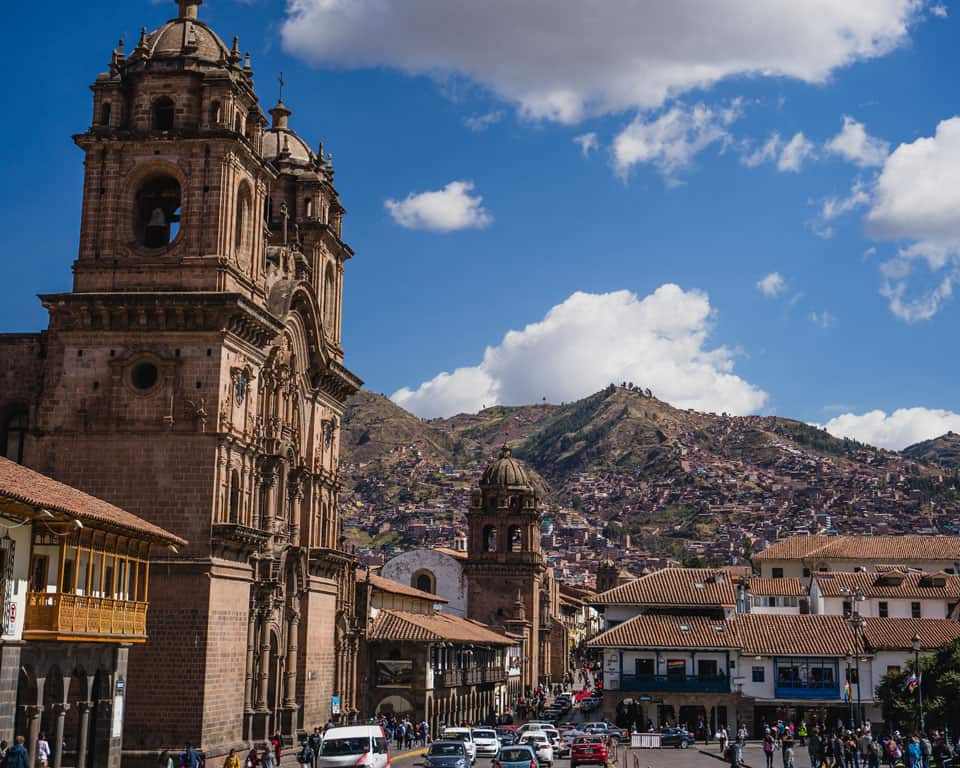
Cusco, the former capital of the Inca empire, is one of the most unique cities in Peru to visit. From the Incan ruins such as Sacsayhuaman to the indigenous people walking down the street, Cusco is bustling with traditional Peruvian culture.
The timeless cobble-stoned streets with gorgeous historical buildings are sprawling throughout the city, making it a photographer’s dream.
As the former capital of the Inca empire, Cusco is also a great base to explore the nearby Incan artifacts. Sacred Valley, Machu Picchu, and Rainbow Mountain are some of the best places to visit in Peru. And guess what? Cusco is the perfect place to stay for all those attractions.
As the top travel destination in Peru, it shouldn’t surprise you that Cusco has some of the best traditional foods in Peru. Try out cuy (guinea pig) and alpaca meat when you are in Cusco!
2. Huacachina, The Dreamy Desert Oasis
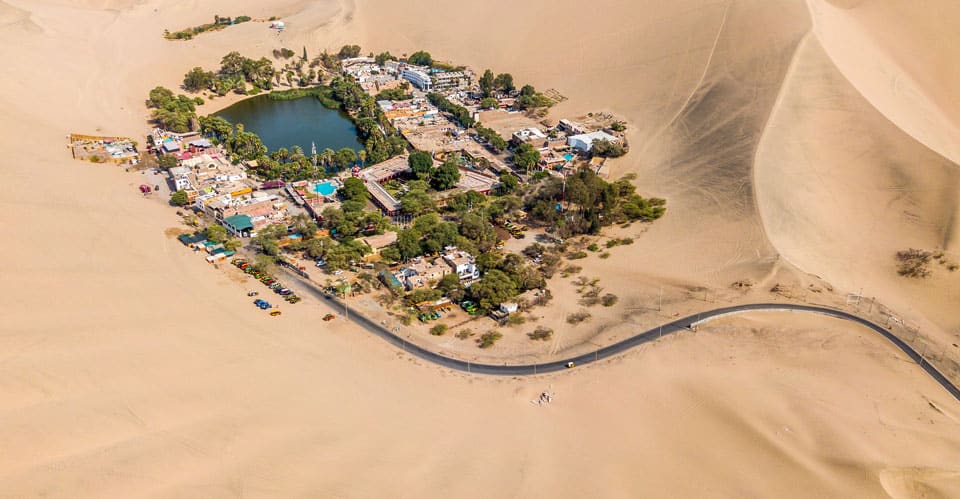
Suggested By: The Wanderlust Within
Huacachina is a desert oasis in the Ica desert in southwestern Peru. In the center is a green lagoon surrounded by palm trees and a small village.
Huacachina is a great place to relax for two or three nights and is around 5 hours south of Lima. You can spend your days relaxing by the sand dunes (which looks like something out of Aladdin) or head out into the desert on a dune buggy to try your hand at sandboarding on Huacachina’s tall dunes.
Sandboarding tours run 3 times a day but later times are advisable as the weather is much cooler. However, if wine is more your thing, then join one of the local winery and Pisco tours. You’ll get to try Pisco Sour, the national drink of Peru.
Hiking to the top of one of the dunes in time for sunset is one of the must-do things in Huacachina, but make sure you give yourself plenty of time as hiking uphill in the sand is tougher than you think!
3. Iquitos, Gateway to the Amazon Forest
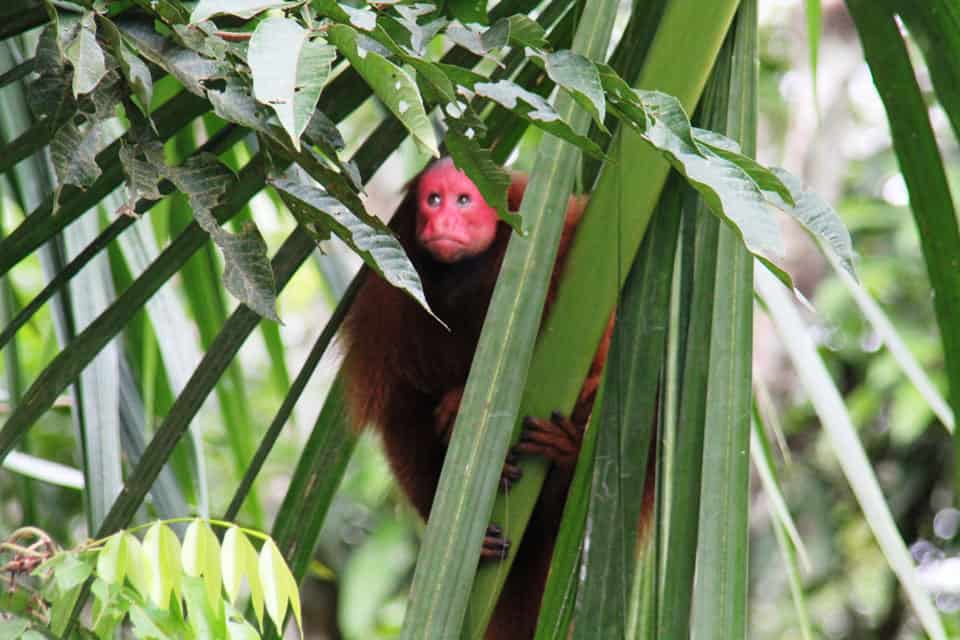
Iquitos is a small city in the middle of the Peruvian Amazon rainforest that you cannot get to by road. Yes, you heard me right! The only way you can get there is by flying or by boat through the Amazon jungle.
This makes it pretty unique, and while the city in itself isn’t the most pretty in Peru, it is the gateway to a unique jungle experience. You can book multi-day tours in Iquitos that take you through the Amazon river to stay in lodges in the rainforest. You have the chance to explore the exotic flora and fauna of the region. You might even see pink dolphins if you are lucky!
I recommend paying a little extra to get a little farther away from the city for a better experience.
In Iquitos, you should visit the street market in Belén and walk past the stilt houses raising over the Itaya River. This is the poor area of the city, so respect the people and think about how you photograph so the locals don’t have to feel uncomfortable and get the impression that their poverty is a tourist attraction.
In the heart of the historic center, the main square, Plaza de Armas is surrounded by 20th Century European-influenced buildings. Down towards the waterfront, there are numerous bars and restaurants to connect with other travelers and locals.
4. Lima, Peru’s Capital

Suggested By: Backpackers.wro
Lima is the capital of Peru and one of the most diverse cities we’ve seen in South America. Lima is a large and dynamically developing city and one of the most popular tourist destinations. Currently, every third inhabitant of Peru lives in the capital. The oldest university on the continent (founded in 1551) is also located in Lima.
It is worth visiting the colonial heart of Lima, and one of its biggest attractions. Take a walk between the two largest squares of the old town – Plaza San Martin and Plaza de Armas.
Both can delight with their enormity and monumental buildings. At Plaza San Martin, it’s worth taking a look (entrance is free) at the lobby of the Grand Hotel.
If you like sacred art, don’t miss the monastery of St. Francis. The area of the old town was included in the UNESCO World Heritage Site List in 1988.
The gastronomy of Lima is one of the top reasons why travelers visit from all over the world. With 2 restaurants in the top 50 restaurants in the world, make sure you try Peruvian cuisine when you visit Lima. Also, don’t forget to try ceviche, the national dish of Peru when you are there!
If you are looking for a good place to stay in Lima, we recommend Miraflores. It is one of the safest districts in Lima and the heart of the tourism industry. This is where you will find the largest and widest range of hostels, cinemas, restaurants, bars, and music clubs.
If you are not sure what to do in Peru, a visit to Lima is always a good idea!
5. Arequipa, One Of The Coolest Cities In Peru
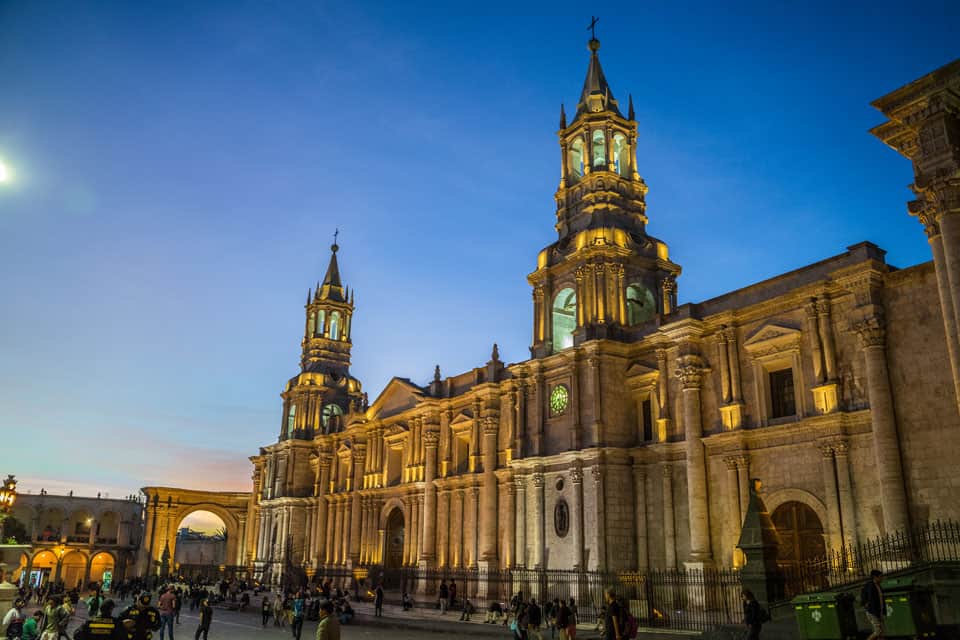
Peru’s second-largest city Arequipa doesn’t get as much attention from tourists as you might expect. Known as the “white city” due to the colors of buildings, Arequipa is a fascinating city full of colonial heritage.
At the center is the main square, Plaza de Armas, with the cathedral, porticoes, and important neoclassical buildings.
From here, a grid-like structure of streets takes you through the historic city center. There are 49 blocks of the original Spanish layout, and you’ll find churches, mansions, offices, plazas built in the years after Arequipa was founded in 1540.
If you’re looking for things to do in Arequipa, it’s easy just to wander and explore. There are lots of great places to eat and drink, the quaint Callejon del Solar neighborhood is worth visiting, and the main landmarks are all around the central square.
One of the most interesting activities is visiting the Santa Catalina Monastery, where you’ll learn how the girls were anything but humble!
A bus from Lima to Arequipa takes about 15 hours but it’s very safe and comfortable and reasonably priced. Otherwise, you can take a two-hour flight. A bus from Cusco is about ten hours.
6. Huaraz, The Hiking Capital of Peru
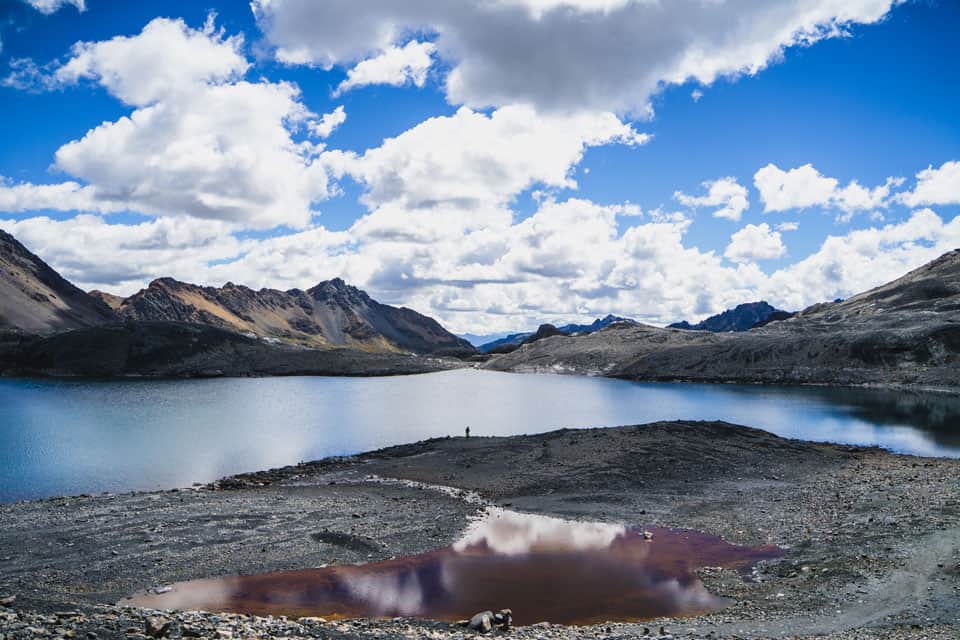
Huaraz is the often skipped-over high-altitude city on the edge of the Cordillera Blanca. The city itself is exciting with a packed Mercado Central, a really lovely Plaza de Armas, and a trout hatchery (if you’re into that kind of thing), but the real charm of the city lies in what surrounds it.
Because just beyond the chaos is Huascaran National Park. The UNESCO Biosphere Reserve and World Heritage Site park spans 340,000 and contains one of the most stunning sections of the Andes – the Cordillera Blanca.
Just a few hours from the city, you can find 400 lakes and jagged peaks climbing as high as 6768m. Diverse wildlife and plant species like the Queen of the Andes.
There are famously challenging day hikes from Huaraz like the one to Laguna 69 which will have you at a glacial lake by mid-day and back to the city by evening. And if you’re open to more ambitious undertakings, Huaraz is the ideal adventure base.
You can find an inexpensive tour or rent everything you need to undertake 4-day Santa Cruz Trek or 10-day Huayhuash Circuit; both have you hiking past brilliant lagoons and high passes, and are some of the most underrated treks in Peru.
7. Mancora, Peru’s Best Beach Town
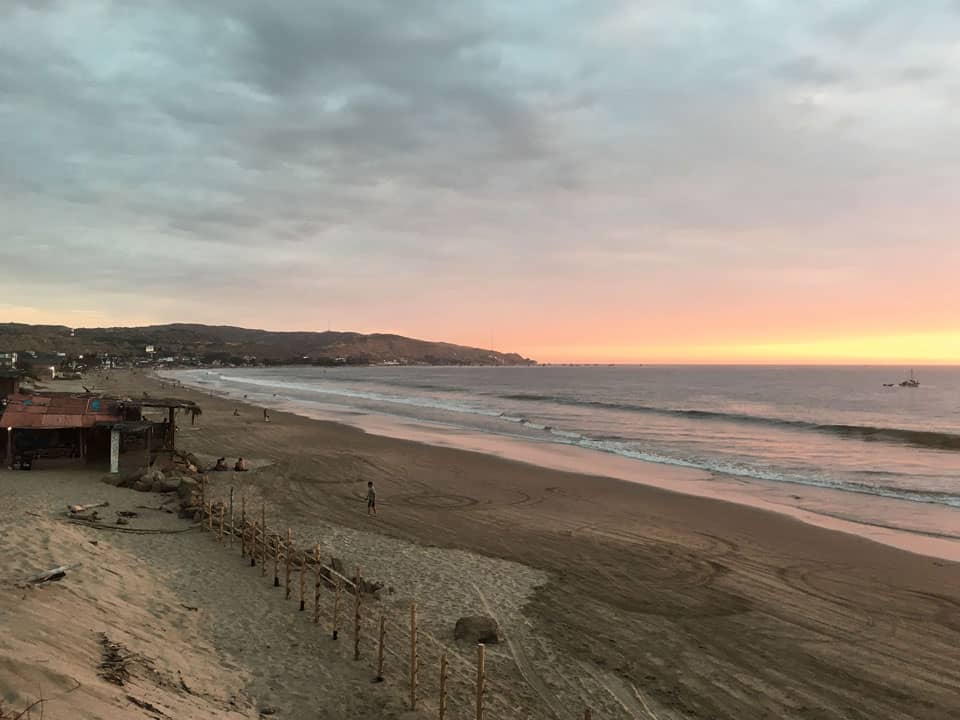
Located in the far north of Peru, Mancora is a small resort beach town next to the Pacific Ocean that yet attracts a lot less international tourists than the rest of the country.
For those busing around South America, Mancora and Huanchaco are probably the two greatest spots to stop over in order to split the journey on the way to or from Ecuador or even take time away from the high altitude of the Andes.
For travelers coming from Ecuador, they can choose to take the night bus from Cuenca to Mancora.
Although, Mancora has a reputation for being a place aimed at party animals that also lacks security at night… Nevertheless, the town has managed in the past few years, to attract a crowd of hippy-ish travelers and backpackers who enjoy a few days of rest by the beach or on the look for some cheap off-the-beaten-path experiences.
Mancora has, in fact, countless activities to offer. Here, you will find a relaxing place, where you can chill, surf all year long, learn how to kitesurf or even go whale watching and swim with green turtles!
The ceviche – a Peruvian dish made of raw fish – will for sure be one of the freshest you will get to taste and the barbecued lobsters, one of the cheapest dinners you will find!
In terms of accommodation, there are plenty – from the wooden hut hosting bunk beds to the party hostels or the luxury hotels and apartments with a swimming pool and direct access to the beach.
Mancora truly is a beautiful place that deserves more than its reputation. Check out this article to learn more about all the awesome things to do in Mancora.
Best Hikes in Peru
Divided by the mighty Andean Mountain Range, Peru is home to some of the most stunning hikes in the world. Though beautiful, many of these hikes in Peru are situated at high altitudes, so many sure you take the proper precaution before doing any trekking!
8. Catarata de Gocta, 3rd Highest Waterfall in the World
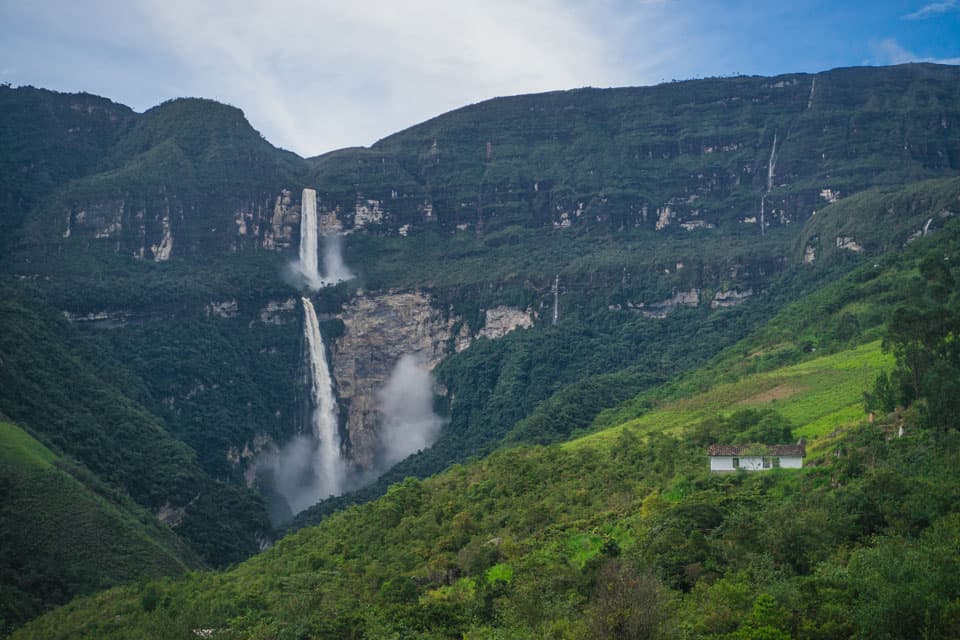
There are many places to visit besides Machu Picchu, such as Catarata de Gocta, one of the tallest waterfalls in the world. Depending on the way you measure it, Catarata de Gocta can either be the 3rd tallest waterfall to the 5th tallest.
Either way, the power of the Catarata is immense. Measuring at 771 meters tall, you will truly understand the definition of nature’s wrath.
To get to Catarata de Gocta, you should base yourself in the Amazonas city of Chachapoyas. From there, it becomes an easy day trip that you can do by yourself or with a guide.
The hike to Catarata de Gocta is a beautiful one, traversing through lush environments. However, the 1.5-hour path can get muddy and slippery so prepare accordingly.
9. Laguna 69, The Best Day Hike in Huaraz
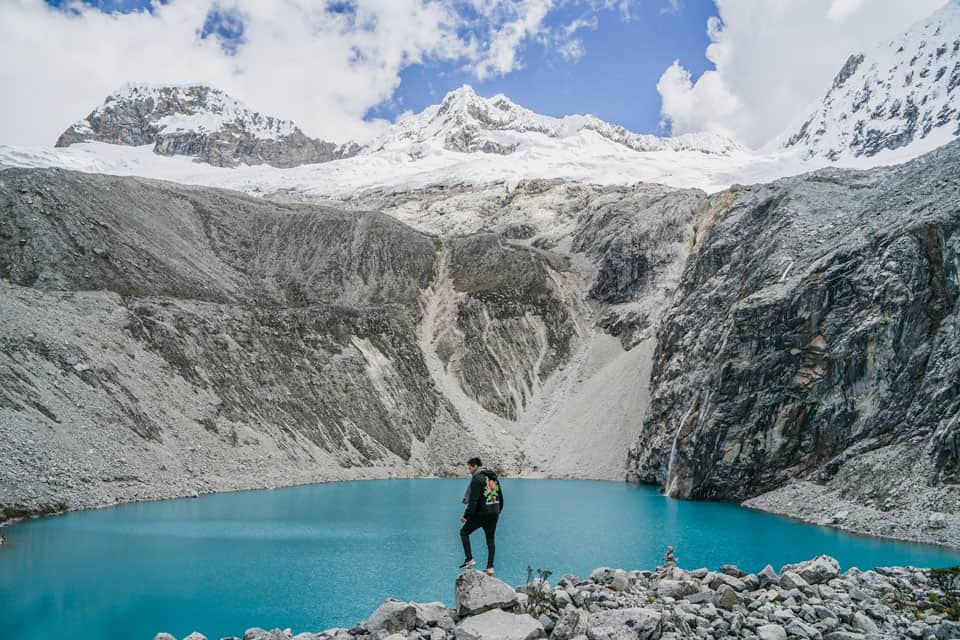
Laguna 69 is one of the toughest day hikes from Huaraz, the Peruvian capital of hiking. Though it is the most challenging hike, it is also the most rewarding day hike. Photoshopped-blue water, snow-capped mountains, gushing waterfalls, wildlife on the path, the whole trek is a scene from a fantasy movie.
However, all good things take a little bit of sacrifice. In this case, it will be a lot of sweat, water, and coca leaves. Though a single-day trek, Laguna 69 is known to be difficult for even experienced hikers.
At an altitude of 4600m, altitude sickness can become a real problem. In addition to that, the total trek time is 6 hours. Though only 6km one way, you will be gaining lots of elevation quickly.
10. Inca Trail, a Must-Do in Peru
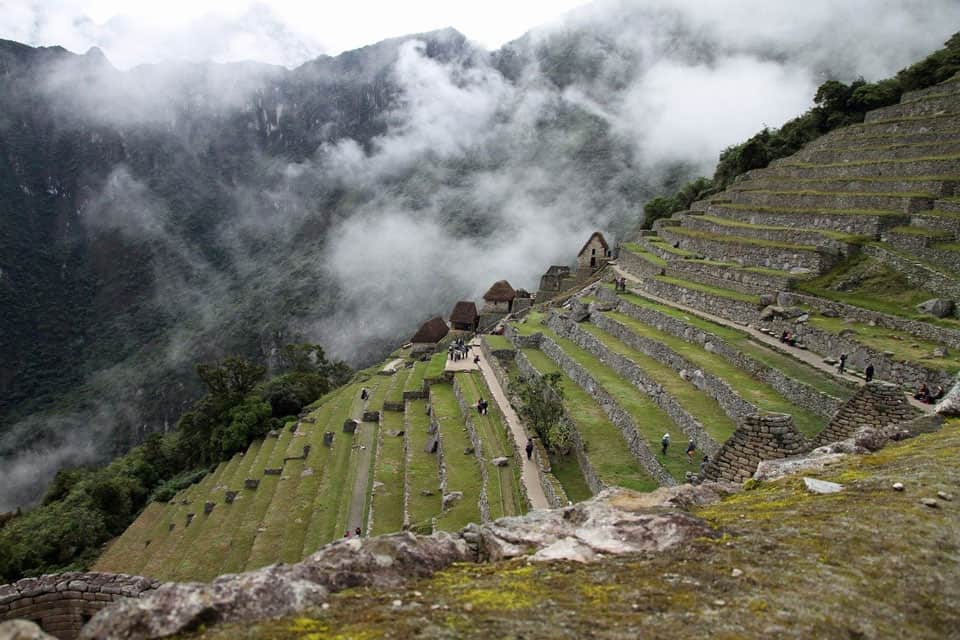
The Inca Trail is the most popular hiking trail in Peru because it leads to Machu Picchu, one of the Seven Wonders of the World. This 4-day hike is arguably the best thing to do in Peru.
Allowing only 500 people (only 200 are tourists) a day on the trail, the opportunity to hike the Inca trail is rare. Visitors wanting to take the Inca trail will often have to reserve months in advance, or maybe up to a year if it is high season.
The 4 days of hiking will definitely be some of the toughest hiking you will ever do in your life. However, the experience will be unlike any other. Hike through the Sacred Valley of Peru using the same paths that the historical Incans built to connect their settlements. You will explore Inca ruins after ruins and learn about the history of these ancient ruins.
Finally, after 4 days of going back in time and immersing yourself in the history of the Incans, you will arrive at Machu Picchu. But you won’t arrive at the entrance of Machu Picchu, you will go through the Sun Gate at Macchu Picchu, a historical place that the Incans used to go through.
11. Hike Rainbow Mountain and See the Beautiful Colors
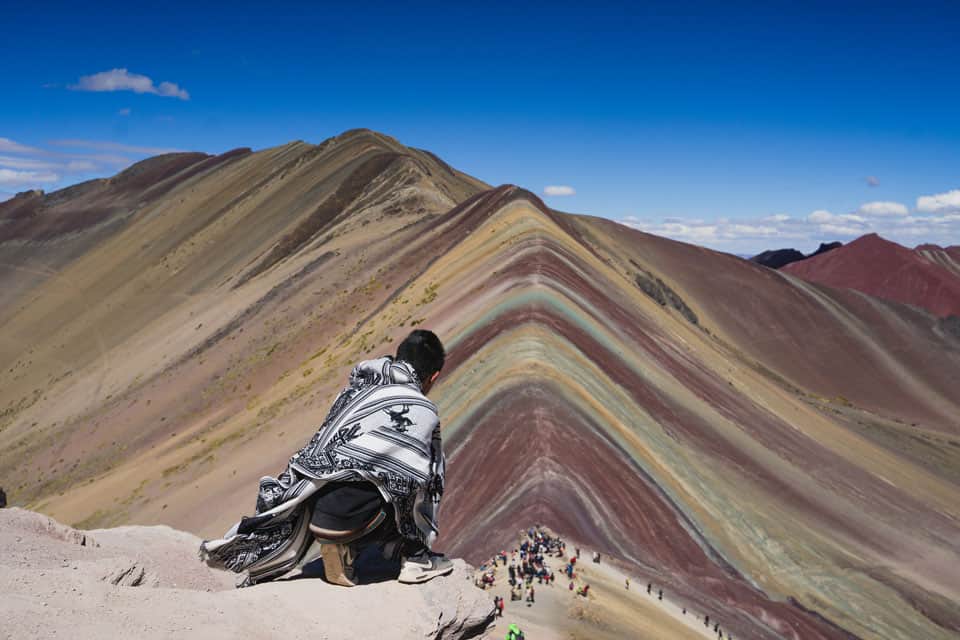
If you are heading to Peru, a top favorite country of mine, you must not miss out on Rainbow Mountain one of the most iconic attractions in Peru. Originally named Vinicunca, in Spanish, it’s called La Montaña de Siete Colores (Mountain of Seven Colors).
Located roughly 4 hours outside of Cusco, the beautiful mineral sediments of red, purple, gold, and turquoise literally stopped me in my tracks. In the quiet of nature and altitude, there is just nothing more stunning.
A day trip to Rainbow Mountain can be accessed via an organized tour or on your own. I recommend going on your own especially if you or anyone in your group speaks Spanish. You can negotiate a taxi from Cusco the night before and get a set rate on the day.
This gives you control over what day you go for the weather, the time you go to avoid crowds and the ability to stay as long as you wish.
I highly recommend 2-3 days to acclimate to Cusco before you even attempt Rainbow Mountain as you will be finishing the hike (or horse ride) at 16,000 feet. Take it slow and bring plenty of water to stay hydrated.
Weather varies with the season but it is known to become pretty cool to cold at the top. Next to Machu Picchu, this is an attraction in Perú you don’t want to miss. Don’t forget to bring your passport to get a cool Peruvian souvenir stamp!
12. Salkantay Trek, The Best Alternative to the Inca Trail
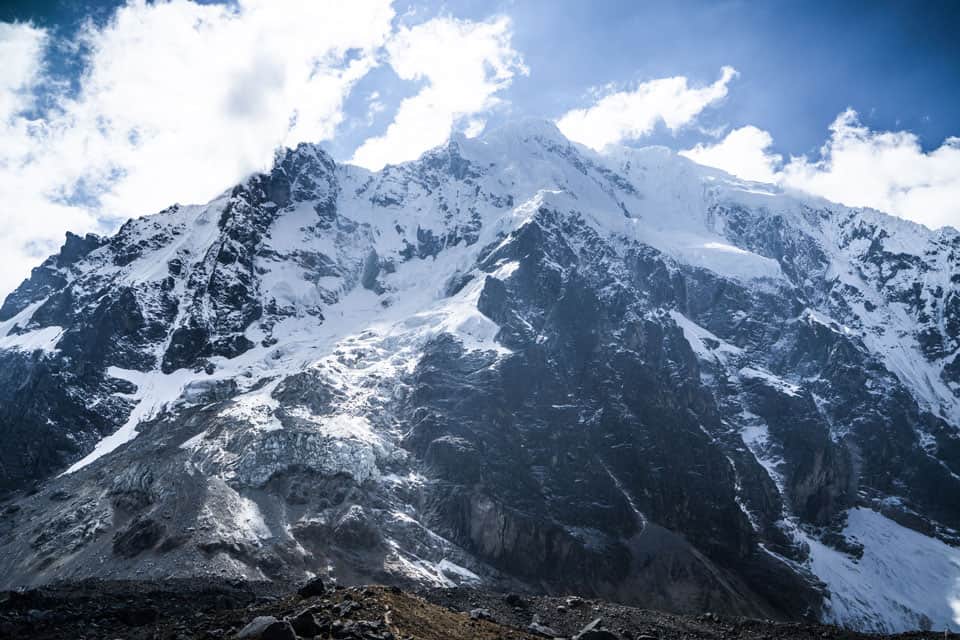
Trekking to Machu Picchu is a backpacker rite of passage. However, now that there is so much advance planning needed in order to do the Inca Trail, many travelers have sought out alternatives. The Salkantay Trek is the second most popular way to reach Machu Picchu on foot and it showcases some of the best scenery that Peru has to offer.
This hike traverses through many high-altitude landscapes which culminate in you crossing the Salkantay pass, a whopping 4,600 meters above sea level. In my opinion, the trek is worth it for this one point alone as it is possibly the most beautiful place in Peru.
As most South America visitors already know, hiking at altitude can be tough, especially when you are as high as the Salkantay Pass. I was never prescribed Diamox prior to my visit so instead opted to prevent altitude sickness naturally.
I would definitely recommend allowing yourself some time in Cusco to acclimatize before tackling this trek!
13. Laguna Paron, Biggest Glacial Lake in The Cordillera Blanca
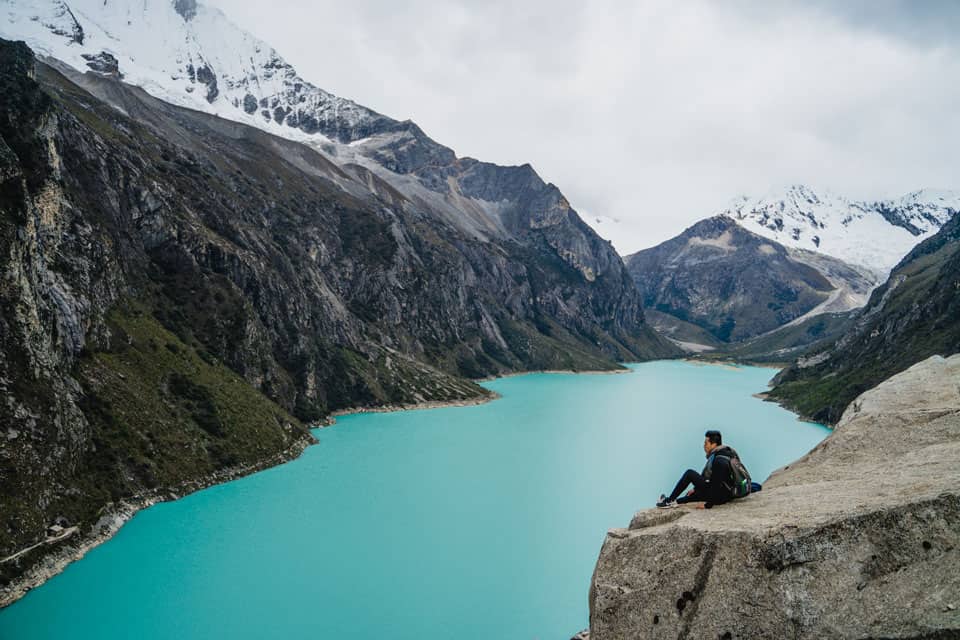
Laguna Paron is one of the most rewarding day hikes in Huaraz, Peru. It is the biggest lake in the Cordillera Blanca. However, Laguna Paron is not just any typical lake.
Located 4,200m in altitude, the minerals from the nearby mountains have settled into Lake Paron, turning the color to a pastel blue. Some might look at the photos and think that the color has been post-processed.
Not only do you get to see the beautiful water of the lake, but also the summit of mountain Artesonraju. What is the significance of this mountain? Good question. Artesonraju mountain is the same mountain that the famous film company Paramount Studio uses as its logo!
With only a short hike of an hour, you can see both natural beauties with your own eyes. Even though the trek is short, be aware that Laguna Paron is at an altitude of 4,200m, an altitude that could easily cause altitude sickness. Take your utmost precaution against altitude sickness.
14. Visit Palccoyo, the Quiet Alternative to Rainbow Mountain
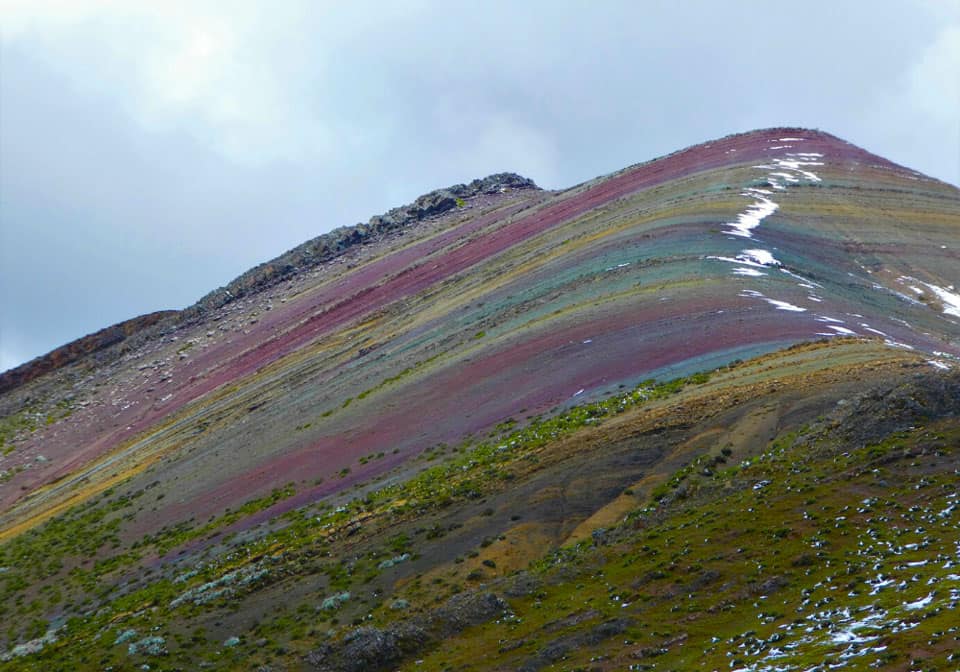
A visit to Peru’s rainbow mountains must be on everyone’s bucket list. The Rainbow Mountains are stunning. The variety of colors that you see here are from the natural minerals present, iron and copper primarily.
Most visitors looking for Peru’s rainbow mountains head to Vinicunca. It’s famous for the tough hike, the gorgeous scenery and the thousands of other travelers. That’s why you should head to the lesser-known rainbow mountain of Palccoyo instead.
It’s a little further to drive – 3.5 hours rather than 3. It’s about 300 meters lower in altitude than Vinicunca and the walk takes around 30 minutes rather than 3 hours.
But the absolute best reason to visit Palccoyo rather than Vinicunca is that there are significantly fewer people there.
The day we visited Palccoyo, we 5 were the only people on the mountain. The rainbow mountain of Palccoyo is peaceful, tranquil and – I hope as empty for you as it was for us.
15. Colca Canyon, One of the Best Hikes In Peru
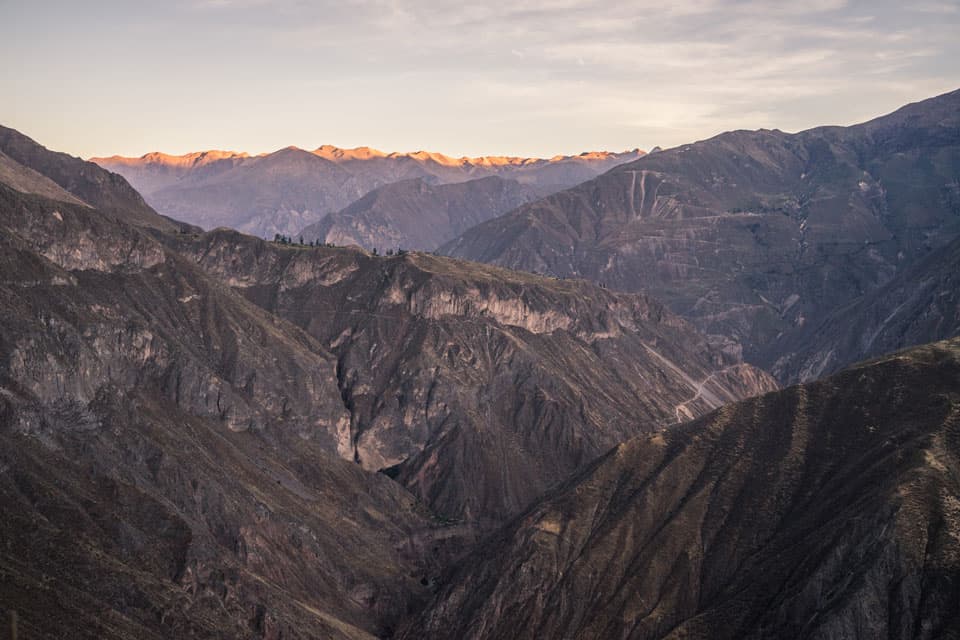
With twice the height of the Grand Canyon, the Colca Canyon is one of the most impressive hikes in Peru. Most people come to see the Andean condor that flies through the canyon.
Representing the heavenly world in Peruvian culture, the condors are the most sacred bird in Peru. In addition to these spiritual animals, the landscapes and the traditional villages are equally spectacular.
The best way to explore this region is by doing the challenging Colca Canyon trek in and out of the canyon. Although possible in 2 days it is much better to take at least 3 days. This allows you much more time in the villages that you come across once you are down in the canyon.
It’s a steep climb out again, but the views are some of the best in Peru. From Arequipa, it is possible to arrange tours into the Colca Canyon. Some do even offer day trips by bus, but this is really only for those short on time because you will only get to see the tip of the iceberg.
16. Humantay Laguna, A Beautiful Lake in the Andes Mountain
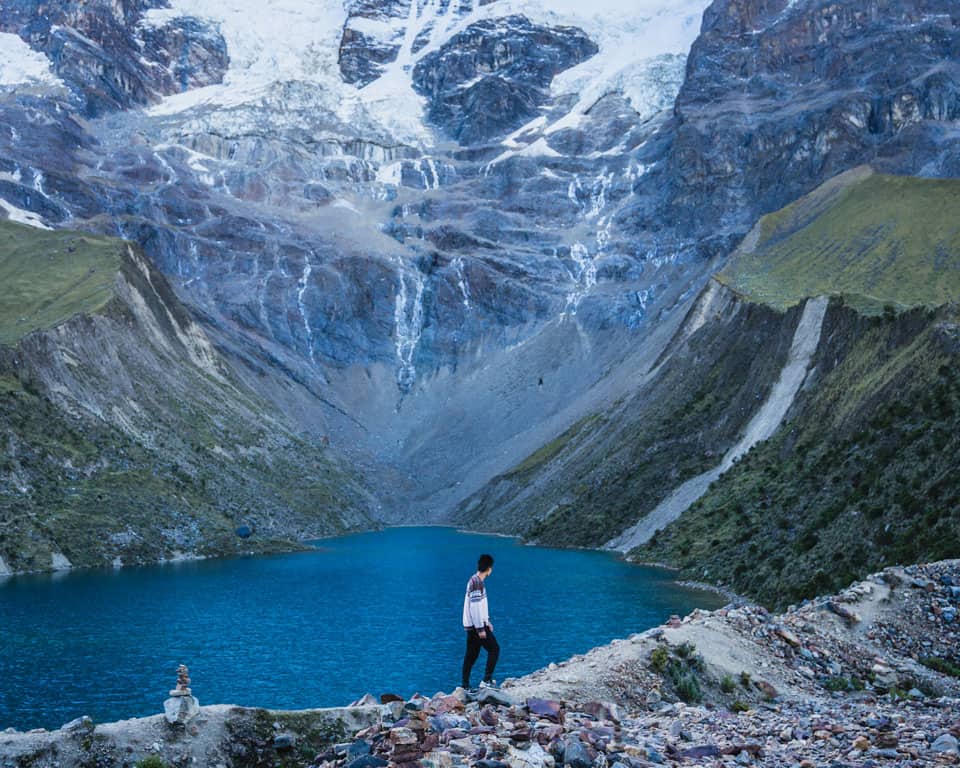
Humantay Lake, or Laguna Humantay in Spanish, is located 4,200m in the Andes mountain of Peru. The best way to visit the Humantay Lake is through a tour from Cusco, or on the way of the Salkantay Trek to Machu Picchu.
Archaeologists believe that the Humantay Lake was sacred to the Incas, as still visible by the offerings (stacks of rocks) you will see on the perimeter of the lake.
Besides being a sacred place, the view there is simply incredible. Crystal blue water surrounded by snow-capped mountains, crisp air and breezy gusts of wind, it feels like you are on a proper adventure.
The hike to Humantay Lake is only about 1.5 hours one way from Soraypampa, the start of your ascent. It is a fairly easy hike compared to the other hikes you can do in the Andes region of Peru.
Though fairly short, proper precautions should be taken to prevent altitude sickness. 4,200m is an altitude that is no joke. No one should attempt hiking Laguna Humantay without proper acclimatization.
17. Glacier Pastoruri, A Disappearing Glacier
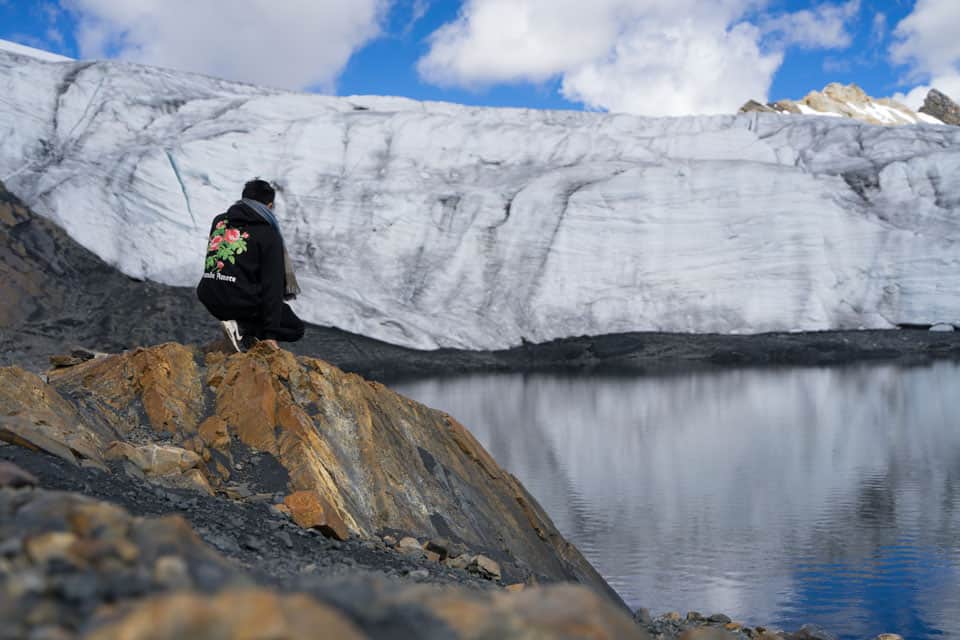
Glacier Pastoruri, located 5,000m above sea level in the Cordillera Blanca, is by definition not a glacier anymore. That is because in the winter month, Glacier Pastoruri is no longer building ice. Spaning 8 square kilometers, Glacier Pastoruri is simply a big piece of ice that will eventually melt away and disappear.
However, Glacier Pastoruri might disappear but it will never be forgotten. As one of the tourist destinations affected by climate change, it sends a message to everyone in the world. It certainly won’t be a thing to do in Peru for much longer.
While it is still there, Glacier Pastoruri is a popular day hike from Huaraz, the Peruvian capital of hiking. The best way to visit Pastoruri is with one of the affordable tours everywhere in Huaraz.
On the tour, you will be transported to the beginning of the hike. Luckily, the hike is only 30 minutes one way, making the trek much more manageable considering the high altitude. Make sure you have enough coca leaves (Peruvian coffee) when you visit Glacier Pasoruri.
18. Choquequirao, An Off-The-Beaten-Path Inca Ruins
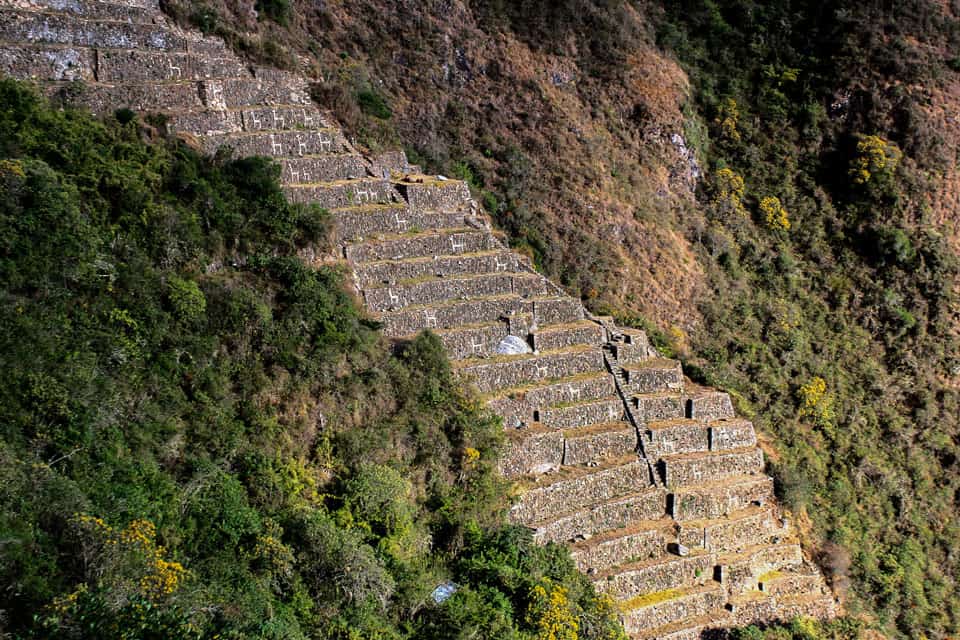
Choquequirao is definitely amongst the best and most unique places to visit in Peru! But let me tell you why it should be on your bucket list right now!
Choquequirao is the “other” lost city of the Incas, but a lot less well known than Machu Picchu. Unlike Machu Picchu, excavation continues today at Choquequirao and archaeologists believe that the ancient ruins of this Inca city are much more extensive than its more famous counterpart.
For example, the incredible llama terraces were only discovered in 2002 – and new additions are found every year.
Folks ‘in the know’ opt to visit Choquequirao vs Machu Picchu because they can sometimes be alone in the ruins – that is right, just themselves – or perhaps a handful of other travelers.
At the moment the only way to access Choquequirao is via a difficult 4-day trek – 2 days in and 2 days out. There is a new route “The Choquequirao Huanipaca route “which means you don’t backtrack over the same ground but you still need to allow 4 days.
Make sure you are well acclimatized to altitude before trekking.
Best Attractions in Peru
19. Machu Picchu, One of the Seven Wonders of the World

Did you think a Peru bucket list would be complete without Peru’s most famous landmark, Machu Picchu? As one of the Seven Wonders of the World, Machu Picchu is a place you must visit in Peru.
Beautiful, historical, and breathtaking, it is one of the most visited tourist attractions in Peru, and even the world. The most popular way to visit Machu Picchu is through the traditional Inca trail, a 4-day trek that passes through ancient Inca ruins and finally arrives in Machu Picchu through the Sun Gate on the last day.
Machu Picchu is so important because it was never discovered by the Spaniards when they arrived. Everything that was left is in its original form, providing scientists and archaeologists with crucial information about the Inca culture and architecture.
However, if you are not hiking the Inca trail, it is advised to stay in Machu Picchu town (called Aguas Calientes) the night before. Then the next day you can visit Machu Picchu for the best views and a minimum amount of tourists.
As the most popular destination in Peru, Machu Picchu is becoming a victim of over-tourism. As a result, the Peruvian government has implemented many rules and regulations to reduce the effects of human erosion and restore the pristine Machu Picchu it once had.
Now there are so many things you need to know before visiting Machu Picchu.
20. Uros Floating Islands at Lake Titicaca
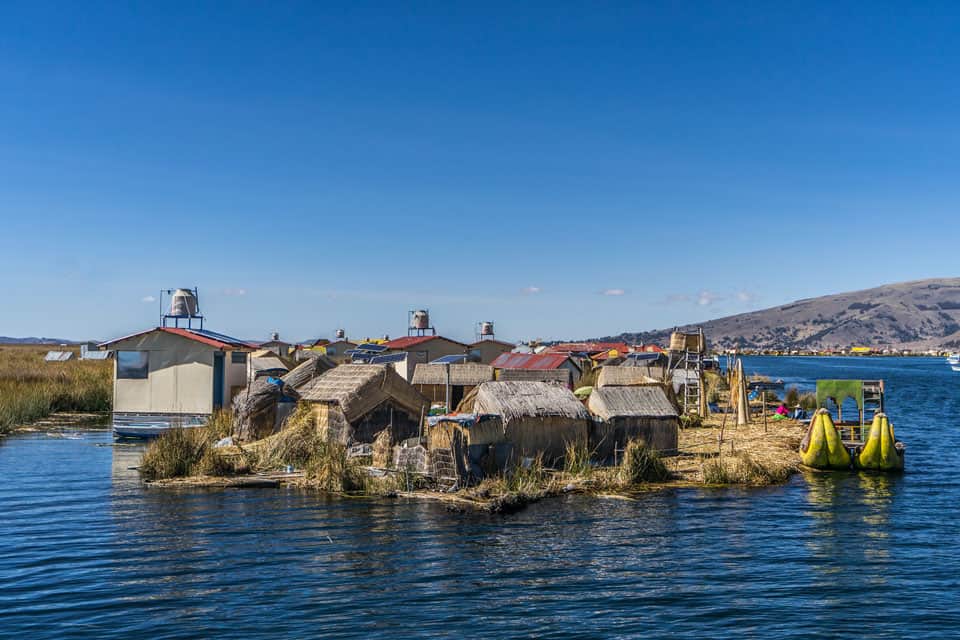
Suggested By: VoyageWriters
On the world’s highest navigable Lake Titicaca of Peru, you’ll find the floating islands of the Uros people. These islands number more than 100 and are entirely made by hand using totora reeds. It is one of the most unique things to do in Peru.
The Uros are welcoming and sustain themselves by fishing, small-scale farming, and selling handicrafts to tourists. From the port of Puno, you can take a guided tour of the islands.
Having a guide who can speak the language as well as explain the fascinating 1000-year-old plus history and traditions of the island’s inhabitants, is recommended.
As an increasing number of young people leave the island to seek higher education, they are often reluctant to return to such a simple way of life. It’s sad to think that in our lifetime, this culture may only exist as a tourist attraction. Like Machu Picchu, now is the time to visit.
21. Kuelap, Machu Picchu of Northern Peru
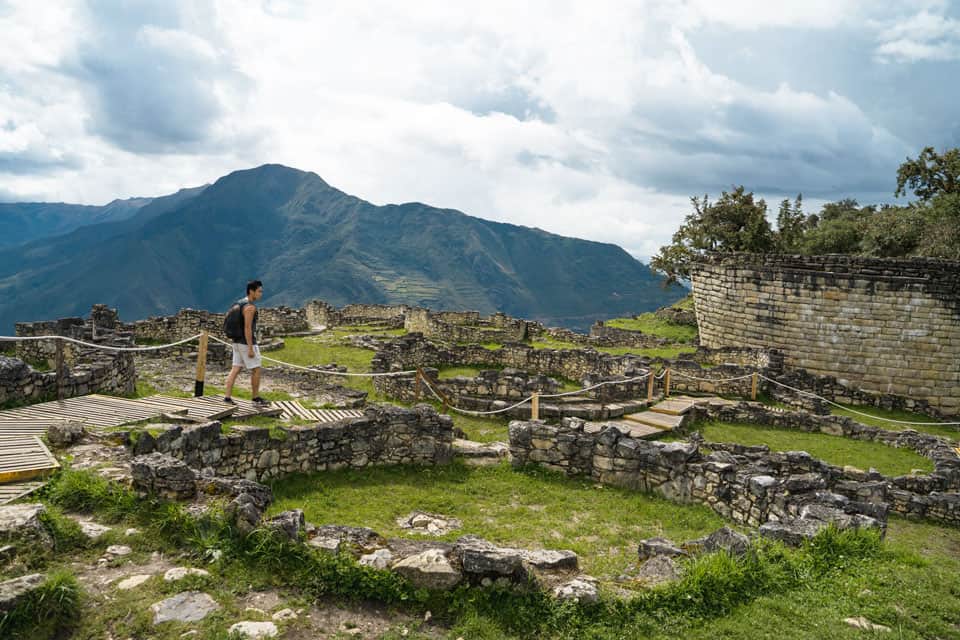
Kuelap, also known as “Machu Picchu of Northern Peru”, is a destination that most visitors miss. This off-the-path attraction is a true hidden gem in Peru. Many travelers believe that Kuelap is a relic of the past left by the Incans, but the truth is, Kuelap was not built by the Incas.
Kuelap was built by the Chachapoyas, or Warriors of the Clouds, a group of indigenous people that existed before the Incas.
Eventually, the Chachapoyas were conquered by the Incas. However, situated more than 3,000m above sea level in the midst of cloud forest and mountains, Kuelap was never discovered by the Spaniards when they arrived.
The high walls of Kuelap were thought to be a fortress protecting against foreign invaders but in fact it wasn’t. Kuelap was a citadel and no battle had ever taken place there. Kuelap was eventually abandoned because the Incans had to support the battles that were occurring in the battlefronts.
Make sure you visit Kuelap when you are traveling in Peru. It is an easy day trip and one of the top things to do in the Amazonas city of Chachapoyas!
22. Moray, Inca’s Agriculture Lab
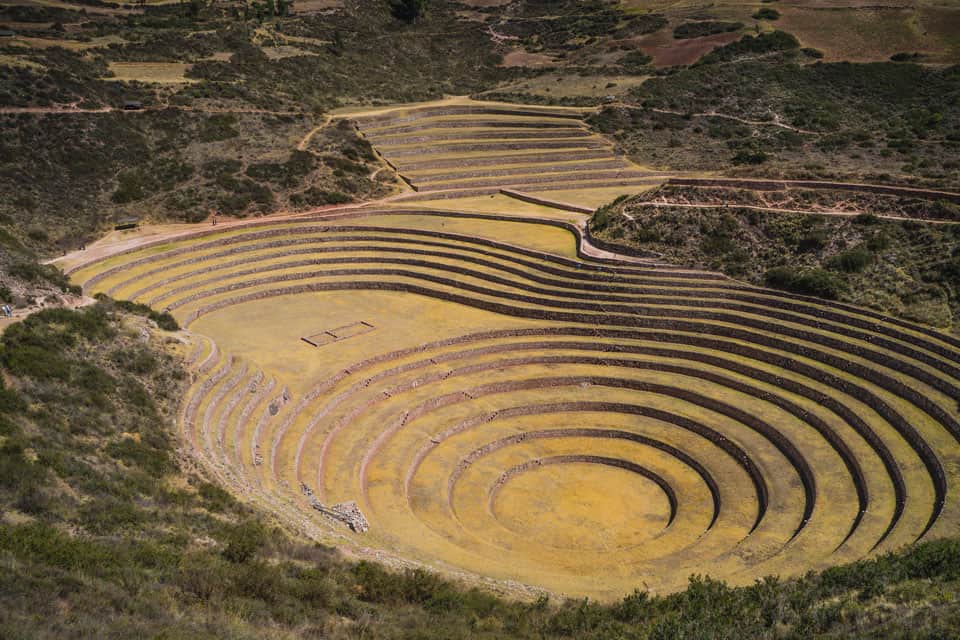
By: Nomad By Trade
Moray is one of the most mysterious Inca sites in the Sacred Valley. Full of strange-looking tiered circles in the ground, they definitely have a bit of an unusual and alien feel.
The prevailing archaeological theory is that the Incas used the area for experimentation with crops as the different altitudes and amounts of sun each section receives would have different effects on the plants.
Entrance to Moray is included in the Sacred Valley tourist ticket along with many of the other important Inca sites in the area. Once you’re there, there is a trail with a good amount of stairs that take you down along the largest, most central one, and others can be seen if you continue down the path.
A visit can be easily paired with nearby Salineras de Maras, which we did on our super affordable taxitour from Cusco.
23. Explore Paracas National Reserve, Where Desert Meets the Ocean
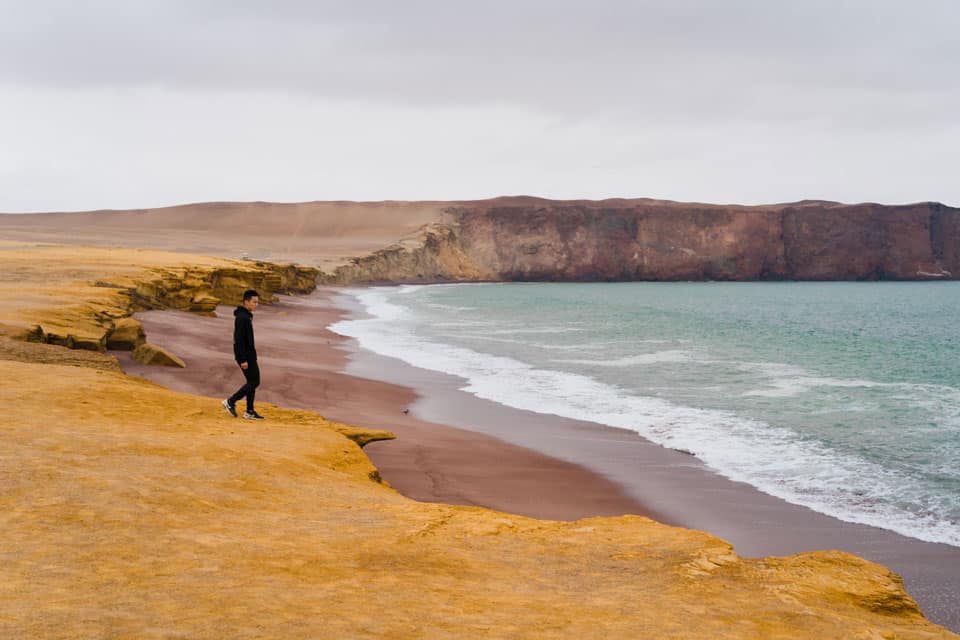
The Paracas National Reserve is one of the top things to do in Paracas. A protected area consisting of desert, ocean, and islands, the Paracas National Reserve is diverse in every way. The 3350 km² park is filled with beautiful beaches and marine wildlife such as sea lions and seals.
Paracas National Reserve is also home to the Candelabra geoglyph, a symbol carved into the same similar to the ones found in Nazca. No one knows the true origin of the meaning of the symbol.
For those adventurous travelers, Paracas National Reserve is the perfect place to bike through. Rent a bike and bike through the vast desert, eventually leading you to the turquoise water of the Pacific Ocean.
Make sure you visit the Playa Roja, or Red Beach, when you are in Paracas National Reserve. the stark contrast between the red sand and the blue ocean water will be one of the best things to see in Peru.
24. Visit Chan Chan, World’s Largest Adobe City
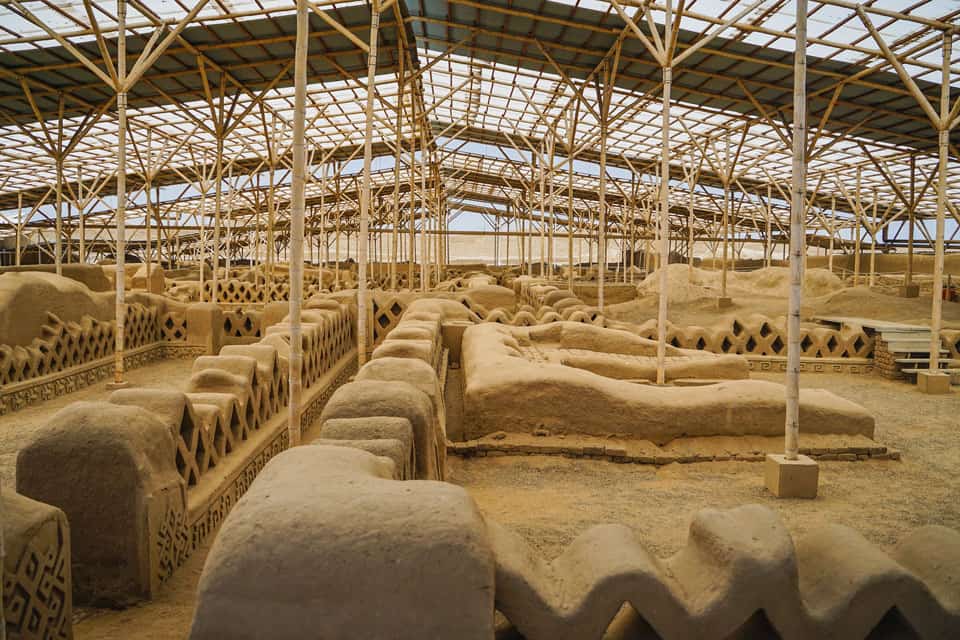
Chan Chan is located in northern Peru and is a UNESCO world heritage site. It is near the city of Trujillo and outside the small surf town of Huanchaco. It was the largest city built by the Chimu culture which resided here from around 900-1470AD.
Open to the public is one of the citadels that was built for the king as his final resting place. Here you can visit the main plaza where the Chimu king would be brought from his burial chamber each year and offerings would be left for him to take back to the afterlife.
You can also see storage rooms, smaller plazas, the ceremonial reservoir, and the kings’ burial chamber.
It is a great place to visit to learn about the people who ruled Peru before the Incas and to find out about how these people lived and died.
I would recommend that you get a guide as there is very little information inside Chan Chan, so that you can really learn about the culture and exactly what you are seeing.
25. See the Mysterious Nazca Lines
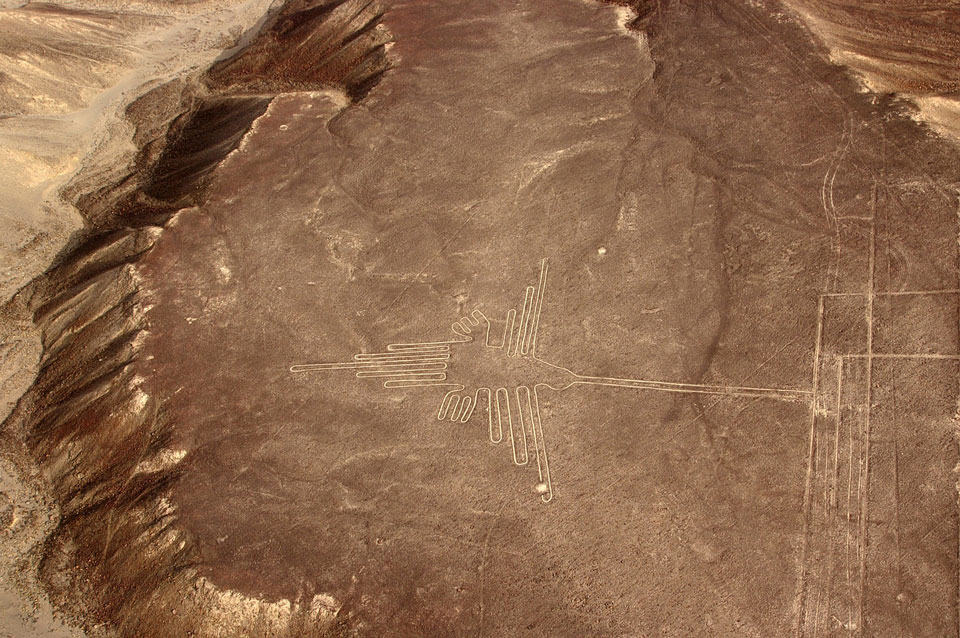
Suggested By: Laure Wanders
The Nazca lines are an impressive collection of over 300 geoglyphs that are carved into the sand and rocks of the Nazca Desert. These etchings of people, animals, and objects were discovered during the 1930s when planes started flying over the desert.
What’s so fascinating about these figures is that no one really knows what purpose they serve but it’s estimated that they were made 500 to 2000 years ago. Although it’s possible to see 3 of the geoglyphs from a viewing platform on the ground, the best way to see the Nazca lines is by flying over them in a small airplane.
The flight, which can be booked in the town of Nazca, takes about half an hour and you’ll be able to see 13 figures. It’s a unique experience in Peru that will make your trip unforgettable!
26. Visit Ballestas Island to See Some Native Marine Life
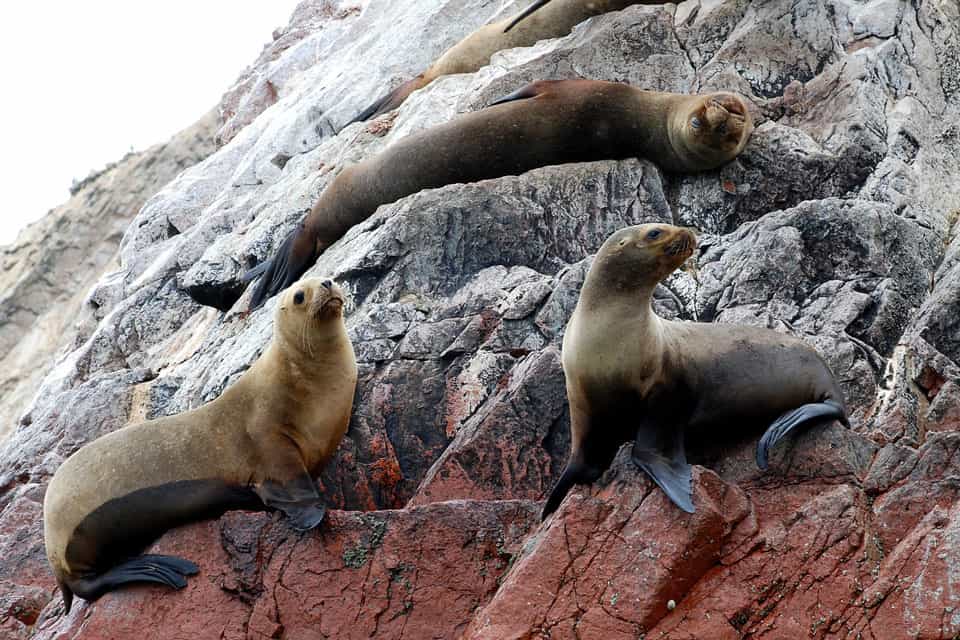
Interested in seeing some of the native wildlife in Peru? Look no further. Ballestas island, nicknamed the “poor mans Galapago”s, is a group of rocky islands located 24 km (15 mi) off the coast of Paracas.
Known as the home of many different native species such as the Humboldt penguins, seals, sea lions, and much more. This is the perfect place to visit in Peru for families with young kids!
Visitors are welcome to take a 2-hour boat ride starting from the coastal city of Paracas. The boat takes the passengers adjacent to these precious wildlife animals. However, no personnel is allowed to physically set foot onto the islands, as doing so could damage their habitat.
One of the best ways to visit the Ballestas Islands is to do it as a day trip from the city of Ica. Combine your visit to Ballestas Island with a bike ride through the nearby Paracas National Reserve and you will have yourself an unforgettable Peru vacation.
27. Salineras de Maras, One of the Four Places in the World to Make Pink Salt
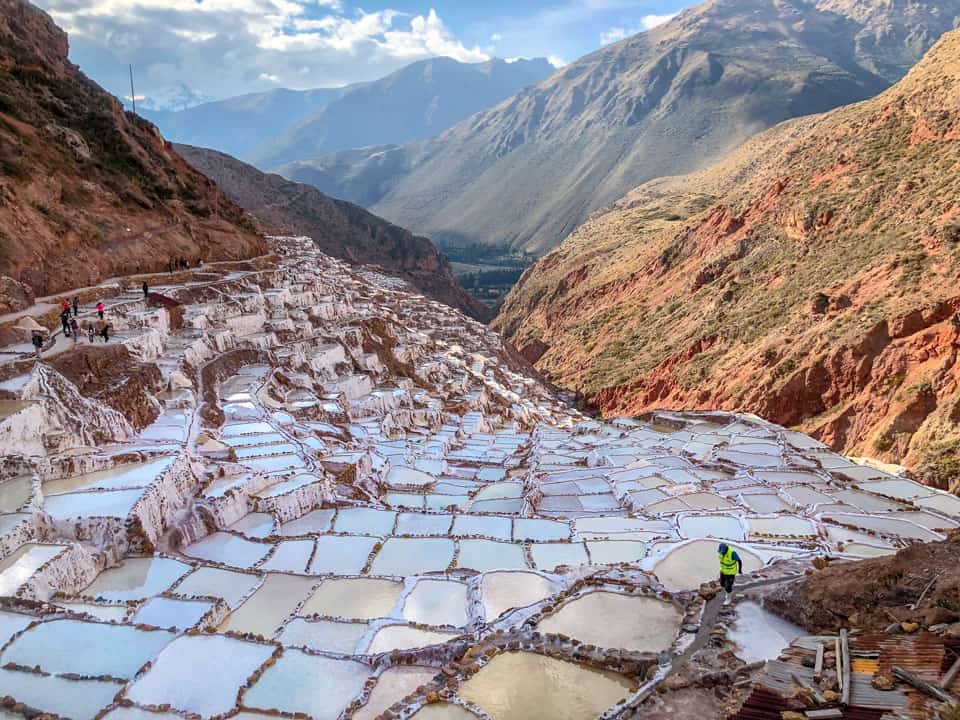
Visiting the Maras salt mines, or the Salineras de Maras, is an essential part of exploring the Sacred Valley. If it is not on your Peru bucket list then it should be.
The Salineras de Maras is an ancient architectural wonder with thousands of small salt wells carved onto a hillside. Incredibly, they operate today exactly as they did in the time of the Incas.
Naturally, salty water runs down canals and is diverted into small ponds alongside the mountain. As the water evaporates it leaves behind the salt which is then harvested by hand by local families.
The Maras salt mines are best seen as part of a full-day Sacred Valley tour. Many other amazing sites are in the nearby area and hiring a private guide or going with an established tour company will help you see them all in the most efficient way possible.
Keep in mind that Peru has recently restricted access into the salt pans due to health concerns. Therefore, a guide will be helpful not just so you get valuable information, but so you can access the best viewpoints.
28. Ollantaytambo, An Important Village in the Sacred Valley
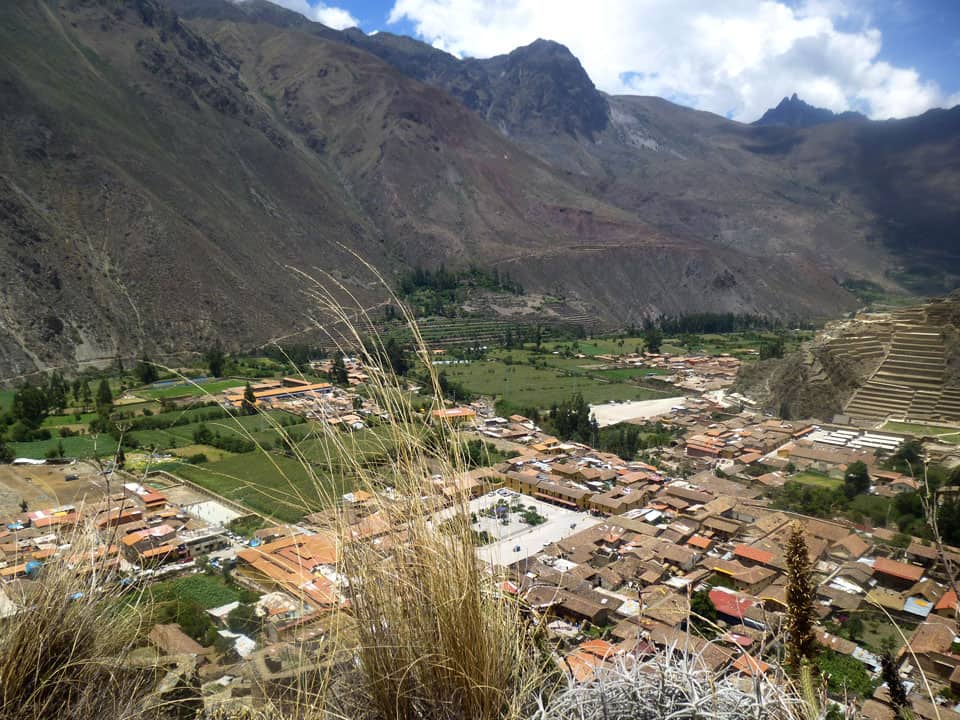
More often referred to as “Ollanta” by locals, Ollantaytambo is one of the most beautiful stops you can make on the way to Machu Picchu. The town is located two hours and a few thousand feet lower than Cuzco, making it the perfect first stop for those worried about altitude sickness.
Ollantaytambo is also fully walkable, with a variety of local Peruvian restaurants and western-style eateries, as well as plenty of free sites to fill a day or two.
The main archaeological park in town attracts hundreds of tourists each day, but just a few meters from the main square is another one, completely free for the public to respectfully explore.
Hotels in Ollantaytambo are all quite affordable, with the few upscale options located closer to the train station. Less than 20 minutes ride from town is bustling Urubamba, the famous salt mines of Maras, and the walking market in Pisac.
If you’re there from October to December, you can’t miss the fresh local strawberries from the farm just outside the main square!
29. Sacrofagos de Karajia, A Relic of the Chachapoyas People
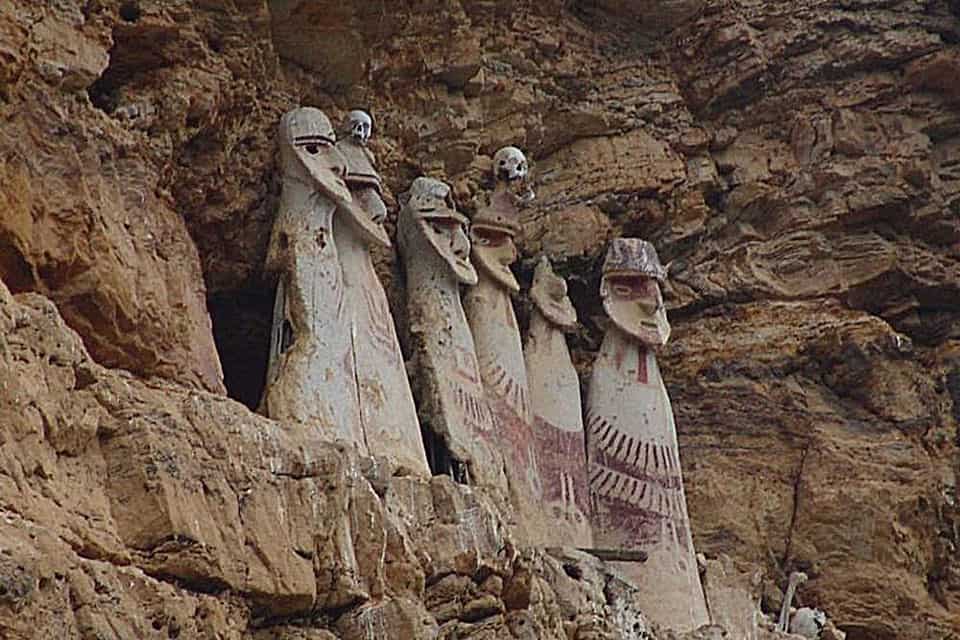
Suggested By: The Nomadic Vegan
When it comes to historical and archaeological sites in Peru, most people know only about Machu Picchu and the other Inca sites near Cusco. But there are other civilizations even older than the Incas who have left behind fascinating glimpses into the ancient past.
One of the most mysterious of these is the painted sarcophagi discovered at Karajía in northern Peru.
The sarcophagi were created by the Chachapoya people, who, until they were conquered by the Inca, ruled their own small kingdom in the Amazonian cloud forest. For this reason, they are sometimes called the Warriors of the Clouds.
When a Chachapoya warrior died in battle, his body was placed in a larger-than-life-sized sarcophagus that was placed high up in a seemingly inaccessible cliff face.
Amazingly, the painted decorations on these sarcophagi are still visible 600 years later. The best way to see them is on a guided day trip from the city of Chachapoyas, about 60 kilometers away.
Tours include transportation, but you will still need to walk the last 40 minutes or so to reach the sarcophagi.
30. Visit Monasterio Santa Catalina, A Convent Filled with Secrets
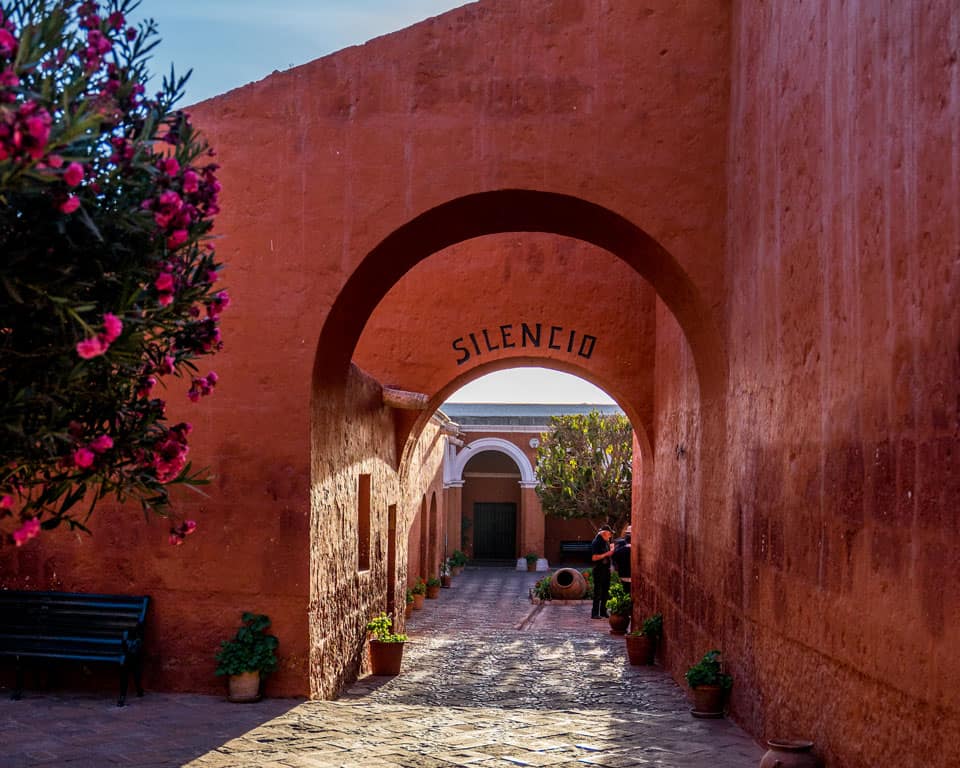
Monasterio Santa Catalina, or otherwise called the Convent of Santa Catalina, is one of the best things to do in Arequipa. Spanning over 20,000 square meters, The Convent of Santa Catalina occupies an entire block in the center of Arequipa.
Monasterio Santa Catalina can sometimes feel like a city within a city, especially with the vivid and bright colors in contrast to the “white city” of Arequipa.
In fact, much of Monasterio Santa Catalina was uncovered recently, when it opened to the public in 1972. Built in the 16th century, for more than 400 years it was invisible to the public. The high walls around the perimeter are the best keepers of the secrets.
Surprisingly, the conditions of the nuns were contrary to what they swore by. All nuns took vows of poverty but some of them can be seen living a frivolous lifestyle, with servants and such.
There is so much mystery to the Monasterio Santa Catalina and it is easily one of the coolest things to do in Peru.
31. Visit Palomino Islands and Swim With Sea Lions
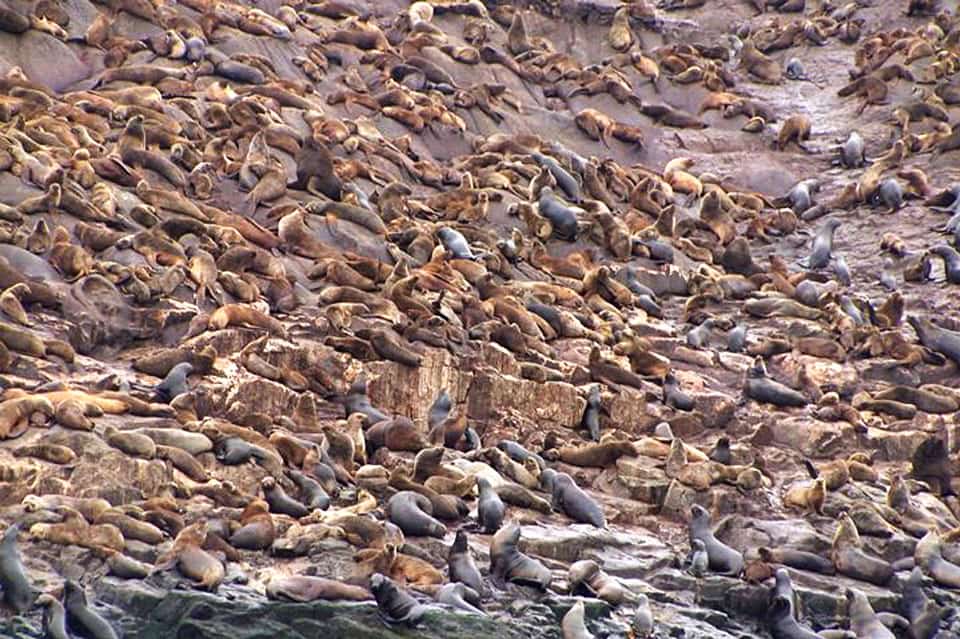
Suggested By: Glitter Rebel
Has it always been your dream to swim between the seals and sea-lions? Then you NEED to head to the Palomino Islands You can easily book a day trip to this group of islands from Lima.
A little boat will bring you to a large rock in the sea that is literally covered with seals and sea lions. This colony, in particular, counts no less than 8000 animals. Although the stench of (rotten) fish is incredible, this is a once-in-a-lifetime experience!
The guides will hand you snorkeling goggles, a wetsuit, and flippers. Do keep in mind that summer is winter in Peru and winter is summer. When arranging a trip in July or August, the water can be very cold.
The sea lions and seals on the rock are very curious animals and love to come close or even “boop” you with their little snout when you are in the water. Although you can’t always stay very long due to the cold, the smell and the animals themselves (not all of them are friendly), an excursion to the Palomino Islands is a dream come true for many!
The Palomino Islands lie just off the coast of Lima and are a great day trip when visiting the Peruvian capital!
32. Puerto Maldonado, The Gateway to the Southern Peruvian Amazon
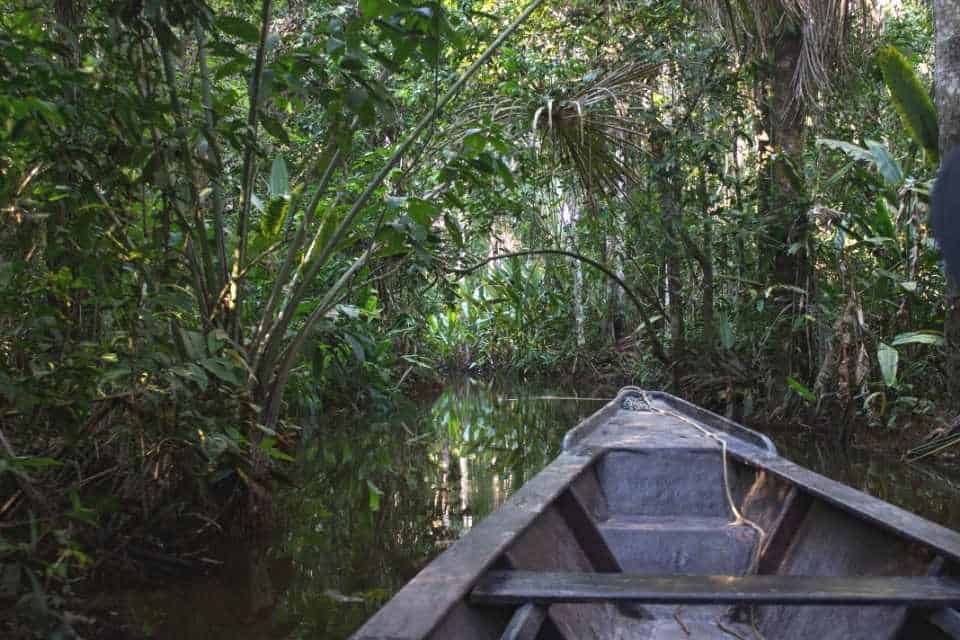
If you are looking to explore the Peruvian Amazon Forest, then Puerto Maldonado is the perfect jump off point. The city is located just inside the Peruvian Amazon, about 55 kilometers (34 mi) west of the Bolivian border.
Thanks to the huge diversity of flora and fauna, Puerto Maldonado has earned the official title of the Capital of Biodiversity in Peru.
There are many things to do in Puerto Maldonado, thanks to its strategic location. Avid nature lovers can check out the Manu National Park, Tambopata National Reserve, and Bahuaja-Sonene National Park. Those three places are deemed as some of the most pristine rainforests in the world.
Peru Packing List
Peru is really diverse country. Ranging from the Amazon rainforest in Iquitos to the high Andes in Cusco, you must properly pack for Peru. Here is our packing list for Peru:
- Sunscreen – Sun at high altitude is very destructive, pack some.
- Insect Repellent – If you plan on visiting the beaches or rainforest, you should consider packing some insect repellent. This one has Picaridin, which is more effective than DEET!
- Filtration Water Bottle – The perfect companion for long hikes and treks. This item will save you so much money and make your hikes much easier.
- Warm clothing, gloves, and hat – Peru, though located close to the Equator, can be very cold due to the altitude. Places like Cusco are cold all year round! Pack some warm clothes with you.
- Rain poncho – A hiking essential, especially if you are visiting the Amazon region of Peru. Though rain could happen unpredictably due to the high altitude.
- Travel Medicine Pack – An essential for any traveler. This medicine pack will have all the medicine you need just in case anyone gets ill.
- Reliable Daypack (Him/Her) – A good daypack is essential for the day hikes you will be doing. This Osprey daypack is my personal favorite.
- Travel Insurance – Hiking at high altitudes can be dangerous, as well as a visit to the Amazon rainforest. Check out our recommendation!
Like this post? Don’t forget to save it on Pinterest!
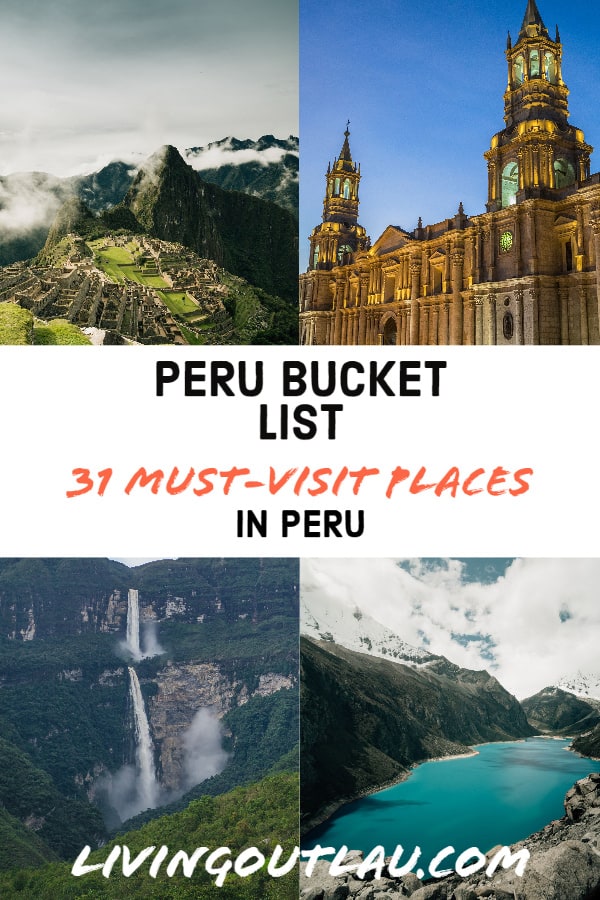
This concludes our Peru bucket list! Some of these Peru attractions will definitely sweep you off your feet! What do you think about this list? Let us know in the comments!
Disclaimer: Some of the links above are affiliate links. That means if you book or make a purchase through the links, we will earn a small commission at no extra cost to you! The money will help run this site! Thank you!
